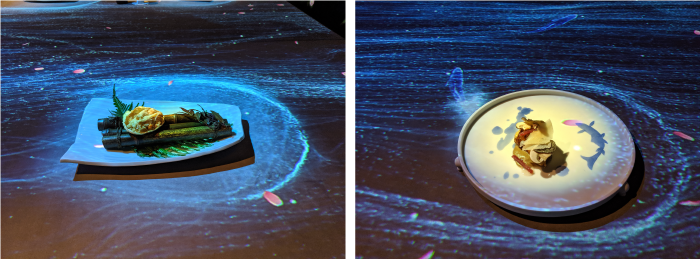Note: This website was automatically translated, so some terms or nuances may not be completely accurate.
Restaurants are no longer just places to eat!? What is Food Entertainment in the Age of COVID-19?
The second installment of the Food Lab's Future Food Project series, "Food Lab Researchers Go There! Future Trends Experience Reports," focuses on the theme of "Restaurant Food Entertainment." Food Lab researcher Watanabe brings you this report.
Originally planned for March, this installment was intended to explore how technology is evolving restaurants through reports on Tokyo dining experiences. However, due to the significant impact of the coronavirus, it is being published at this time.
With restaurants themselves facing a crisis due to COVID-19, predictions for the future of restaurant and food entertainment are undergoing major shifts.
This time, while reflecting on the experience reports, I want to look ahead to what kind of future restaurant and food entertainment will face in the era of living with COVID-19.
Utilizing Technology to Expand Space
A prime example of restaurant entertainment is the use of technologies like AR and projection mapping to create spatial extensions that delight us.
While projection mapping is no longer particularly rare today, what kind of sensation does it create when combined with "food"? What changes or novelty does it bring to the act of eating? We experienced it firsthand.

What you receive isn't just "food," but a "story"
This time, I visited two restaurants in Tokyo. The spaces transformed by projection mapping felt like stepping into another world. Both offered course menus where everything—from the welcome drink to dessert—was meticulously crafted into a story: the selection of ingredients, cooking methods, seasoning, and even how to eat each dish.
You become part of the space, experiencing what it means to "eat a story."
The story's angle differs at each restaurant. At one establishment, the narrative begins even before you start eating. Following your guide into a darkened room, you find the prologue to the story unfolding before you, with mechanisms designed to immerse you in its world.

Eating dishes while feeling like you're part of the story brings a joy akin to watching a play.
Each dish served advances the story, allowing the chef's intentions and vision to be input as information, enabling a more delicate appreciation.
Extending "Seasonality" with Technology
Furthermore, at restaurants centered around experiencing Japan's changing seasons, the dining experience extends beyond the dishes on the plate to encompass the entire table and space.
Nature projected throughout the space, accompanied by the sounds of wind, birds, and insects.
It felt like traveling to a different place while still in the city.
Interactive elements stimulate the senses through engagement with the space.

While "seasonality" is essential in food, experiencing the seasons through the entire environment allowed me to feel the preciousness and gratitude toward nature even more deeply.
In this way, restaurant entertainment evolving alongside technology made me realize that it's not just about "delicious!" but also about the "fun!" that comes beyond that.
And what creates this is the perfect experience design, from the moment you enter the restaurant until you leave. Spatial expansion and staging are built upon this experience design.
The Near-Future Restaurant Enabled by Technology
There are other examples of experience design.
In China, fully unmanned robot restaurants have emerged. These cutting-edge establishments automate everything from ordering and payment to cooking, serving, and service through robots, standardizing both service and quality. Customers can even complete payment simultaneously with their order via a smartphone app. These restaurants are steadily increasing their presence nationwide.
Incidentally, the future vision involves combining these unmanned supermarkets with smart logistics to build smart communities and realize smart cities by leveraging big data from consumption, logistics, and the food service industry.
"Convenience" as Entertainment
Imagining the experience at these unmanned restaurants evokes not just a near-future feel where the entire process is handled solely by robots, but also eliminates the common restaurant annoyances like
・Waiting for staff
• Long waits for food during peak hours
- Time spent paying
will be eliminated, undoubtedly reducing stress.
Leveraging technology to thoroughly eliminate wasted time and enhance convenience.
As an element that makes future dining even more enjoyable, the ability to experience it "smoothly" and "conveniently" will likely become a crucial part of the entertainment experience.
What will the future of restaurants look like in the era of living with COVID-19?
As of June when this is written, the impact of COVID-19 is still far from zero, and restaurants in Tokyo are operating under trial-and-error conditions with restrictions.
The " Guidelines for Business Continuity in the Food Service Industry " (published by the Japan Foodservice Association and the National Federation of Public Health and Sanitation Associations) outlines various measures for restaurants to continue operations.
For example, installing partitions to prevent droplet transmission. Furthermore, to avoid cash transactions, introducing contactless payment methods like electronic money where possible.
Moving forward, we must explore how to design the restaurant experience while implementing measures and considerations suited to the era of living with COVID-19.
How will the value of the "space" change?
There have been developments suggesting the value of the "space" that is a restaurant is undergoing significant change.
In the US, there's a business model called "virtual restaurants" specializing in delivery. Due to COVID, delivery orders surged. These virtual restaurants essentially serve food made in the kitchens of major restaurant chains under a different name, or share kitchen space with other restaurants like a shared office. Consequently, customers ordering from what they thought was a local pizza shop discovered the food was actually made by a major chain.
While users have criticized this practice—ordering to support a local shop only to discover it was actually a major chain—for the food service industry facing pandemic hardships, these restaurants can reduce costs by eliminating the need for physical locations, rent, and serving staff. They are expected to grow further.
The Potential of Virtual Restaurants
While there's a need to bridge the gap between consumer perception and reality, doesn't the concept of "virtual restaurants" hint at something new and promising?
With experiences like online drinking parties gaining traction, attention is shifting toward gathering methods unconstrained by physical space. As technology advances and becomes more widespread, the potential to enjoy food entertainment from home will only expand further.
How we gather with friends online, and even how people connect within the same virtual space. How meals are served and how to recreate them at home. From restaurant service to hospitality.
Collaborations not just with chefs, but also with technologists and directors, open up new possibilities for designing experiences. It might even be possible for your home to take on the role of a restaurant.
But does this diminish the value of the restaurant as a physical space?
I don't think so. Rather, I believe it will become even more meaningful. Going forward, places where people gather will become sacred spaces. The happiness derived from dining, something only truly experienced in person, will increase, becoming more precious and revered.
I'm very excited to see what the new normal for future restaurants and these new experiences will look like.
Finally
Regarding the question in the title: "Will restaurants cease to be places just for eating!?" Initially, it primarily implied the potential for technology to expand the dining experience. However, in the era of living with COVID-19, I believe the emphasis will shift toward restaurants becoming places that strengthen and affirm human connections.
Was this article helpful?
Newsletter registration is here
We select and publish important news every day
For inquiries about this article
Back Numbers
Author

Yukie Watanabe
Dentsu Inc.
Second Integrated Solutions Bureau
Solution Planner
Gained experience in digital promotion and currently engaged in marketing planning within the Integrated Solutions Division. My strength lies in overseeing the entire process from strategy to output.



